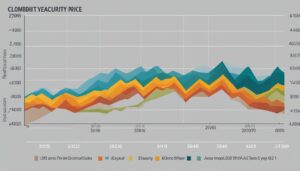Seasonal trends can have a significant impact on commodity markets, affecting trading strategies and investment decisions. Understanding these trends is essential for traders looking to maximize their profits and make informed choices in the market.
Seasonal adjustment is a common procedure used to remove seasonal and calendar effects from economic time series in commodity markets. However, it is important to note that seasonal adjustment does not necessarily improve the quality of economic data, as there is always some loss of information and uncertainty in estimating trends. Additionally, seasonally adjusted data may not be reliable trend indicators and can be revised over time.
Key Takeaways:
- Seasonal trends play a significant role in commodity markets.
- Seasonal adjustment can be complex and may not always improve the quality of economic data.
- Seasonally adjusted data may not be reliable trend indicators and can be revised over time.
- Understanding seasonal indicators is crucial for traders to spot trends and identify support and resistance levels.
- Combining seasonal analysis with other technical analysis tools enhances accuracy and confidence in trading decisions.
Understanding Seasonal Indicators in Commodity Markets
Technical analysis is a powerful method for studying the price movements and patterns of commodities in commodity markets. By analyzing historical data, technical analysts can identify trends and patterns that can help predict future price movements. One essential tool used in technical analysis is seasonal indicators, which measure and visualize the seasonal patterns of commodities.
Seasonal indicators provide valuable insights into how the price of a commodity tends to behave during specific time periods. By understanding and utilizing these indicators, traders can make informed decisions regarding entry and exit points, identify support and resistance levels, and measure volatility.
Examples of seasonal indicators include seasonal charts, seasonal indexes, and seasonal factors. Seasonal charts visually represent the historical price movements of a commodity over a particular season, allowing traders to identify recurring trends. Seasonal indexes quantify the magnitude of a commodity’s price movement during specific time periods relative to its historical performance. Lastly, seasonal factors are statistical tools used to adjust a commodity’s price data, helping remove the impact of seasonality.
These seasonal indicators play a crucial role in technical analysis and can enhance the accuracy and confidence of trading decisions. By recognizing seasonal trends and patterns, traders can align their strategies with historical price movements and increase their chances of success.
| Seasonal Indicator | Description |
|---|---|
| Seasonal Charts | Visual representation of historical price movements |
| Seasonal Indexes | Quantifies price movements relative to historical performance |
| Seasonal Factors | Statistical tools for adjusting commodity price data |
It is important to note that seasonal indicators should not be used in isolation. Traders should combine them with other technical analysis tools to gain a comprehensive understanding of the market. By considering multiple indicators and factors, traders can make more informed trading decisions and improve their overall profitability.
The Role of Seasonality in Specific Commodity Sectors
The change from winter to spring brings about significant seasonal influences in various commodity sectors. Let’s explore how seasonality affects energies, grains and oilseeds, and softs markets, presenting traders with lucrative opportunities.
Energies Sector:
As we transition into spring, the demand for gasoline and natural gas tends to rise. This increase in demand can be attributed to the approaching summer driving season and the surge in electricity needs for air conditioning. As a result, prices in the energies sector often experience a bullish trend during this period.
Grains and Oilseeds Sector:
Spring marks the planting season for grains and oilseeds. Any delays or changes in planting during this critical period can have a significant impact on the projected supply for the upcoming crop year. Traders often observe increased anxiety over the planting season, which can lead to buoyant grain prices.
Softs Markets:
In the softs markets, including commodities like coffee and sugar, the spring season in the Southern Hemisphere corresponds to harvest time. This harvest period can greatly influence prices as it determines the availability of these commodities. Traders should pay close attention to the softs markets during this time, as prices may reflect the abundance or scarcity of the harvested crops.
By recognizing and analyzing seasonal tendencies in specific commodity sectors, traders can identify potential opportunities and make informed trading decisions. The table below provides an overview of the seasonal opportunities present in these sectors:
| Commodity Sector | Seasonal Opportunity |
|---|---|
| Energies | Rising demand for gasoline and natural gas in spring |
| Grains and Oilseeds | Impact of delays or changes in planting on projected supply |
| Softs Markets | Harvest time in the Southern Hemisphere affecting prices |
Understanding the role of seasonality in these commodity sectors can give traders a valuable edge in their decision-making process. By harnessing the potential of seasonal tendencies, traders can capitalize on the opportunities presented by these markets.
Considerations When Using Seasonal Analysis in Commodity Trading
While seasonal tendencies can be a valuable tool in commodity trading, it is important to be aware of their limitations and consider other factors in the market. Seasonal tendencies are based on historical data and may not guarantee future results due to changing market conditions. Limitations in seasonal analysis include the assumption that past patterns will repeat, which may not always be the case. Additionally, external factors such as government policies or unexpected events can disrupt seasonal patterns and render them less reliable.
When using seasonal analysis, it is essential to take into account other influencing factors as well. Fundamental factors, such as supply and demand dynamics, can outweigh seasonal patterns and drive market movements. Technical factors, such as chart patterns and indicators, can provide valuable insights beyond seasonal trends. Psychological factors, including market sentiment and investor behavior, can also affect prices and override seasonal effects.
To effectively utilize seasonal analysis, it is crucial to understand the context of the overall market. This requires considering the broader economic environment, geopolitical events, and relevant industry developments. By combining seasonal analysis with fundamental and technical analysis, traders can gain a comprehensive understanding of market conditions and increase the accuracy of their market forecasting.
| Considerations When Using Seasonal Analysis in Commodity Trading | Limitations | Factors to Consider | Market Forecasting |
|---|---|---|---|
| Seasonal tendencies | Based on historical data | Influence of fundamental, technical, and psychological factors | Combine with other analysis techniques |
| External factors | Government policies, unforeseen events | Context of broader market environment | Enhance accuracy of future predictions |
Conclusion
Seasonal influences play a significant role in commodity markets, providing valuable insights for traders and investors. While seasonal tendencies are not infallible and do not guarantee future results, they reflect fundamental events that consistently occur at the same time each year. By being aware of these events and understanding their impact on prices in the past, traders can gain a competitive edge in assessing trade opportunities.
It is important to note that seasonal analysis should be used in conjunction with other tools and factors to make informed trading decisions. Seasonal trends can provide a useful framework, but they should be considered within the broader context of market fundamentals, technical analysis, and investor psychology. Combining these different approaches can offer a more comprehensive understanding of the market and improve forecasting accuracy.
Ultimately, successful trading involves a careful balance of factors. Seasonal analysis is a valuable tool but should not be relied upon as the sole determinant for trading decisions. By incorporating various tools and considering multiple perspectives, traders can increase their chances of success in the complex and dynamic world of commodity markets.
FAQ
What is seasonal adjustment in commodity markets?
Seasonal adjustment is a procedure used to remove seasonal and calendar effects from economic time series in commodity markets.
How does seasonal adjustment work?
Seasonal adjustment has two stages: the first stage accounts for deterministic effects by regression, selecting a time series model, while the second stage decomposes the time series into trend-cycle, seasonal, calendar, and irregular components.
Does seasonal adjustment improve the quality of economic data?
Seasonal adjustment does not necessarily improve the quality of economic data, as there is always some loss of information and uncertainty in estimating trends.
Are seasonally adjusted data reliable trend indicators?
Seasonally adjusted data may not be reliable trend indicators and can be revised over time.
What is technical analysis in commodity markets?
Technical analysis is a method of studying the price movements and patterns of commodities in commodity markets.
What are seasonal indicators?
Seasonal indicators are tools that help measure and visualize the seasonal patterns of commodities in commodity markets.
How can seasonal indicators help traders?
Seasonal indicators can help traders spot trends, identify support and resistance levels, measure volatility, and generate signals for entry and exit points.
Should seasonal indicators be used alone?
It is important to combine seasonal indicators with other technical analysis tools to enhance accuracy and confidence in trading decisions.
How does the change from winter to spring affect commodity sectors?
The transition from winter to spring has significant seasonal influences on various commodity sectors, such as increased demand for gasoline and natural gas in the energies sector and planting time for grains and oilseeds.
What impact does harvest time in the spring have on softs markets?
Harvest time during the spring in the Southern Hemisphere can have a significant impact on softs markets such as coffee and sugar.
Are seasonal tendencies guaranteed to produce future results?
Seasonal tendencies are based on historical data and may not guarantee future results due to changing market conditions.
What should traders consider when using seasonal analysis?
Traders should consider other factors in the market, such as fundamentals, technicals, and psychology, as they can influence prices and override seasonal effects.
How can traders enhance market forecasting using seasonal analysis?
Traders can enhance market forecasting by combining seasonal analysis with fundamental and technical analysis to provide a strong foundation for making informed trading decisions.
Source Links
- https://cordiercommodityreport.com/seasonal-tendencies-in-commodities/
- https://www.linkedin.com/advice/0/how-can-you-predict-seasonality-commodities
- https://research.macrosynergy.com/what-traders-should-know-about-seasonal-adjustment/
Disclaimer
All information on this website is of a general nature. The information is not adapted to conditions that are specific to your person or entity. The information provided can not be considered as personal, professional or legal advice or investment advice to the user.
This website and all information is intended for educational purposes only and does not give financial advice. Signal Mastermind Signals is not a service to provide legal and financial advice; any information provided here is only the personal opinion of the author (not advice or financial advice in any sense, and in the sense of any act, ordinance or law of any country) and must not be used for financial activities. Signal Mastermind Signals does not offer, operate or provide financial, brokerage, commercial or investment services and is not a financial advisor. Rather, Signal Mastermind Signals is an educational site and a platform for exchanging Forex information. Whenever information is disclosed, whether express or implied, about profit or revenue, it is not a guarantee. No method or trading system ensures that it will generate a profit, so always remember that trade can lead to a loss. Trading responsibility, whether resulting in profits or losses, is yours and you must agree not to hold Signal Mastermind Signals or other information providers that are responsible in any way whatsoever. The use of the system means that the user accepts Disclaimer and Terms of Use.
Signal Mastermind Signals is not represented as a registered investment consultant or brokerage dealer nor offers to buy or sell any of the financial instruments mentioned in the service offered.
While Signal Mastermind Signals believes that the content provided is accurate, there are no explicit or implied warranties of accuracy. The information provided is believed to be reliable; Signal Mastermind Signals does not guarantee the accuracy or completeness of the information provided. Third parties refer to Signal Mastermind Signals to provide technology and information if a third party fails, and then there is a risk that the information may be delayed or not delivered at all.
All information and comments contained on this website, including but not limited to, opinions, analyzes, news, prices, research, and general, do not constitute investment advice or an invitation to buy or sell any type of instrument. Signal Mastermind Signals assumes no responsibility for any loss or damage that may result, directly or indirectly, from the use or dependence on such information.
All information contained on this web site is a personal opinion or belief of the author. None of these data is a recommendation or financial advice in any sense, also within the meaning of any commercial act or law. Writers, publishers and affiliates of Signal Mastermind Signals are not responsible for your trading in any way.
The information and opinions contained in the site are provided for information only and for educational reasons, should never be considered as direct or indirect advice to open a trading account and / or invest money in Forex trading with any Forex company . Signal Mastermind Signals assumes no responsibility for any decisions taken by the user to create a merchant account with any of the brokers listed on this website. Anyone who decides to set up a trading account or use the services, free of charge or paid, to any of the Broker companies mentioned on this website, bears full responsibility for their actions.
Any institution that offers a service and is listed on this website, including forex brokers, financial companies and other institutions, is present only for informational purposes. All ratings, ratings, banners, reviews, or other information found for any of the above-mentioned institutions are provided in a strictly objective manner and according to the best possible reflection of the materials on the official website of the company.
Forex/CFD trading is potentially high risk and may not be suitable for all investors. The high level of leverage can work both for and against traders. Before each Forex/CFD investment, you should carefully consider your goals, past experience and risk level. The opinions and data contained on this site should not be considered as suggestions or advice for the sale or purchase of currency or other instruments. Past results do not show or guarantee future results.
Neither Signal Mastermind Signals nor its affiliates ensure the accuracy of the content provided on this Site. You explicitly agree that viewing, visiting or using this website is at your own risk.




